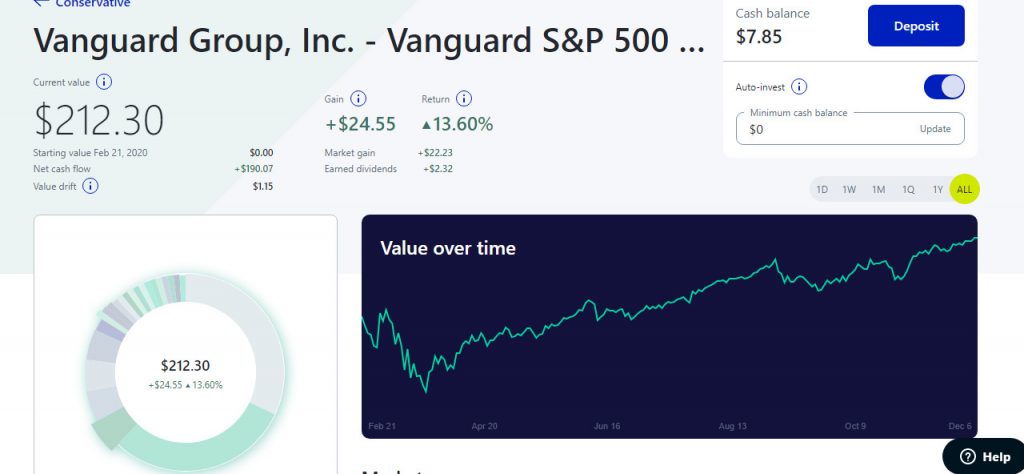Earning money is the first step towards building personal wealth but investing is how you reach true financial freedom with less effort.
Most people trade time for money at a traditional job by working 40+ hours per week for a paycheck. The problem is that your income isn’t scalable because, at some point, you run out of hours of the day that you can work. If you can’t get paid more per hour, you will eventually hit a ceiling on your income.
Millionaires know that they need to leverage their time and money to work for them. They do that by investing in assets that will appreciate over time and generate income passively.
Even if you only have $1,000 and are just starting out, you can take advantage of passive investments to grow your wealth and net worth.
Ready to get started right away? Here’s my top picks for your first investment:
- Invest in S&P 500 Index funds through M1 Finance
- Buy real estate through Fundrise
- Build a diversified portfolio through M1 Finance
- Fully fund your retirement account
- Consider peer-to-peer lending through MyConstant
What is Passive Income?
Passive income is any type of money that you make without trading your time for it. It will generate income by itself without your direct action, usually 24 hours a day, 7 days a week.
Now, this is not to say that passive income sources require no work. They often take a good amount of sweat equity or upfront investment to get them started. Writing a book is a good example where it could take a year of writing to create but then generate consistent income for years to come.
I’m a big fan of passive income because it lets you create extra money every month without doing more work. However, I’m also a huge fan of passive investments that will grow that money over many years.
Earn More by Investing
The difference is that with a passive investment, you purchase rights to an asset. That asset will then appreciate in value or make dividend payments to you.
Passive investments include real estate, stocks, bonds, and precious metals.
The interest you earn off these assets compound and will continue to make more and more money every year. By investing earlier in your life, you’ll make more later with the same amount of money.
For example, let’s say you invest $1,000 when you are 40 at an interest rate of 8%. At the end of 20 years, you’ll have a total of $4,926.80.
If you have invested that same $1,000 at the age of 30 for 30 years, you would have a total of $10,935.73! That’s over double the amount for only 10 more years.
Picking Your First Investment
Before you start investing, I highly recommend making sure that you have paid off any high-interest debt. Credit cards and student loans can have interest rates of 9% or more that are a drain on your budget. If you have low interest rate debt that is less than 5%, it makes more sense to invest and earn 8% or more.
I also highly recommend making sure you have a six month emergency fund in a high-yield and accessible account. The purpose of this is to make sure you have enough liquid money to cover any unexpected costs that might pop up.
Provided you are comfortable with your debt and emergency fund savings, it’s time to start investing to grow your wealth. Luckily, it is very easy to get started using a variety of different platforms and often the minimum is only $500.
One thing to note is that investing should be a long-term strategy. If values go down, resist the urge to sell your holdings. As long as you have a solid investing strategy, you should see those values come back up and continue to make money over time.
Investing does come with risk, so be sure you understand what you invest in and how it may earn or lose money. Always be sure to do enough research before investing, or use an advisor like the Motley Fool Stock Advisor.
Here are our top choices for investing your first $1,000… or whatever amount you have to get started.
1. Invest in an S&P 500 Index Fund
One of the cardinal rules of responsible investing is to diversify your holdings so that you don’t lose everything if one investment does poorly. There is one investment that helps you to diversify your holdings automatically for you.
An S&P 500 index ETF is a fund that tracks the performance of the top 500 major companies in the Standard & Poor stock market. By purchasing this one index, you will see similar performance as all of those top 500 companies.
Historically, the S&P 500 index has averaged around 9.8% over the past 90 years. In the past two years, it has made over 18% each year. While it has certainly seen some down years, it has trended up consistently in the long-term and is generally more stable than individual stocks.
There are several apps that will let you get started investing right away. My personal favorite is M1 Finance because it is easy to use and has no trading fees. Just create an investment “pie” and fund your account to get started.
Here’s a look at my own M1 Finance account with my Vanguard S&P 500 ETF making 13.6% in less than a year.

If you only have a small amount of money and want to start making solid annual returns with relatively low risk, an S&P 500 index fund is the best way to start.
2. Invest in Real Estate
Real estate investing used to be reserved only for people who had sizeable amount of cash that could be used for a down payment on a property. On top of that, you would need to to manage the property, find tenants, and make repairs.
There is an easier way to start investing in real estate with only $1,000. REITs, or real estate investment trusts, are a type of fund that can be purchased like stocks or ETFs. These trusts make it possible to own very small slices of multiple properties and earn consistent dividend income.
While there are many REITs out there, my favorite is Fundrise. Fundrise is a platform that allows you to choose from multiple real estate investing strategies and benefit from both property capital appreciation and dividend payments.
While the market in 2020 from COVID did impact Fundrise with lower rates, they have historically seen between 9% and 12% returns every year. Since they are a non-traded company dealing in real estate, their returns have been independent from the stock market. The low volatility and consistent dividend payments are an attractive option for investors.
3. Build Your Own Investment Portfolio
If you have $1,000 to invest, it is possible to build your own portfolio based on your preferences. M1 Finance is my preferred investment platform because it is very simple to pick exactly what you would like to invest in.
Once you fund your account initially, you’ll be able to build a pie composed of up to 100 slices of different stocks, ETFs, or bonds. This lets you determine how much risk you would like to take and adjust over time.
For example, a more conservative investment strategy would have more bonds than stocks. Bonds have a lower annual rate of return but will fluctuate less and be more stable in a recession. You could also include stocks that you think will perform well for decades to come.
I personally have one conservative pie that is primarily bonds. The rest of it includes blue-chip dividend aristocrats that I think will be steady earners for the long haul.
A more aggressive strategy would have a larger percentage of growth stocks. Tech, energy, and pharma stocks may earn gains well into the double digits but are also more volatile. Be willing to ride out any downturns but this can still be a good strategy to build wealth.
4. Contribute to a Retirement Account
Even if you only have a few hundred dollars extra, you can make considerable returns by investing that money into a retirement account early. If your employer matches your contribution, your $1,000 could turn into $2,000 with their match.
The benefit of contributing towards a 401k is you don’t have to pay taxes on it until you withdraw the money when you are ready to retire. That saves you money now and can defer the taxes until you are able to pay them later.
Traditional and Roth IRAs are another way to minimize taxes and save for your retirement more effectively. A Roth IRA lets your investment grow tax-free and is a good way to avoid having to pay taxes when you retire at 59 1/2 year old.
No matter which type of retirement account you have, contributing as much as you can to it will set you up better for retirement.
5. Peer-to-Peer Lending
Peer-to-peer lending is when you give a loan to someone else in exchange for interest paid back on your original amount. There are a few platforms that help to make this easier, like Lending Club. However, there is still considerable risk involved with this type of investment.
In this method, you are loaning money to individuals. If they don’t repay the loan, you’re out your money, so take that into account when evaluating the risks.
I have used MyConstant and found them to be an easy way to make a solid rate of return. They currently offer up to 7% annual interest rates with 30 day loan terms. They use crypto to back their loans, so the level of risk is lower than some other platforms. If you want to get into peer-to-peer lending, this is definitely the best platform I have found so far.
While I wouldn’t recommend P2P lending as your primary form of investment, it is a solid option as you build your overall strategy.
As you save more money and are able to expand you investments, look to add a few of these options to your portfolio. By diversifying, you’ll be able to generate better average returns, no matter what happens with the rest of the market.
Do you have more money saved up? Here are some ideas on how to invest $10,000 or more like a millionaire.













